In this article, we will discuss classroom management strategies and explore the different types of these strategies, their historical roots, and their evolution into educators’ present-day methodologies.
At the start of the article, we have defined classroom management and have discussed its importance in creating a conducive learning environment that nurtures student engagement and academic success. Then, we have explained various theoretical frameworks that guide classroom management, including behaviorist, humanist, cognitive, and ecological models. Each model provides a unique classroom management perspective and supports different strategies.
The key components of effective classroom management are then explored, such as the classroom setup, establishing rules and procedures, fostering positive teacher-student relationships, effective instructional strategies, and consistent assessment and feedback. The guide underscores the significance of each component and how they work together to create an optimal learning environment.
Following this, the guide details various classroom management strategies. These include proactive and reactive, relationship-building, instructional, and assessment strategies. The guide expands on each strategy, deeply understanding its implementation and potential effects.
The article then addresses classroom management in specific contexts, such as managing disruptive behavior, managing diverse learning environments, and in the context of digital or online classrooms. It offers practical tips and strategies tailored to these situations.
The impact of effective classroom management strategies is discussed in terms of academic performance, student behavior and engagement, and the overall classroom climate. Effective classroom management contributes to a positive learning atmosphere, promoting academic success and the holistic development of students.
The guide concludes with a look at the future of classroom management, exploring upcoming trends and the role of technology. It emphasizes the importance of continuous professional development for educators to keep up with these changes and improve classroom management strategies. It also briefly discusses common challenges that educators face in implementing classroom management strategies and offers innovative solutions to overcome these hurdles.
The article presents a holistic view of classroom management, offering a deep dive into its theoretical underpinnings, practical strategies, impacts, and future trends. It is a comprehensive resource for educators seeking to enhance their classroom management skills and create an optimal learning environment for their students.
Introduction to Classroom Management Strategies
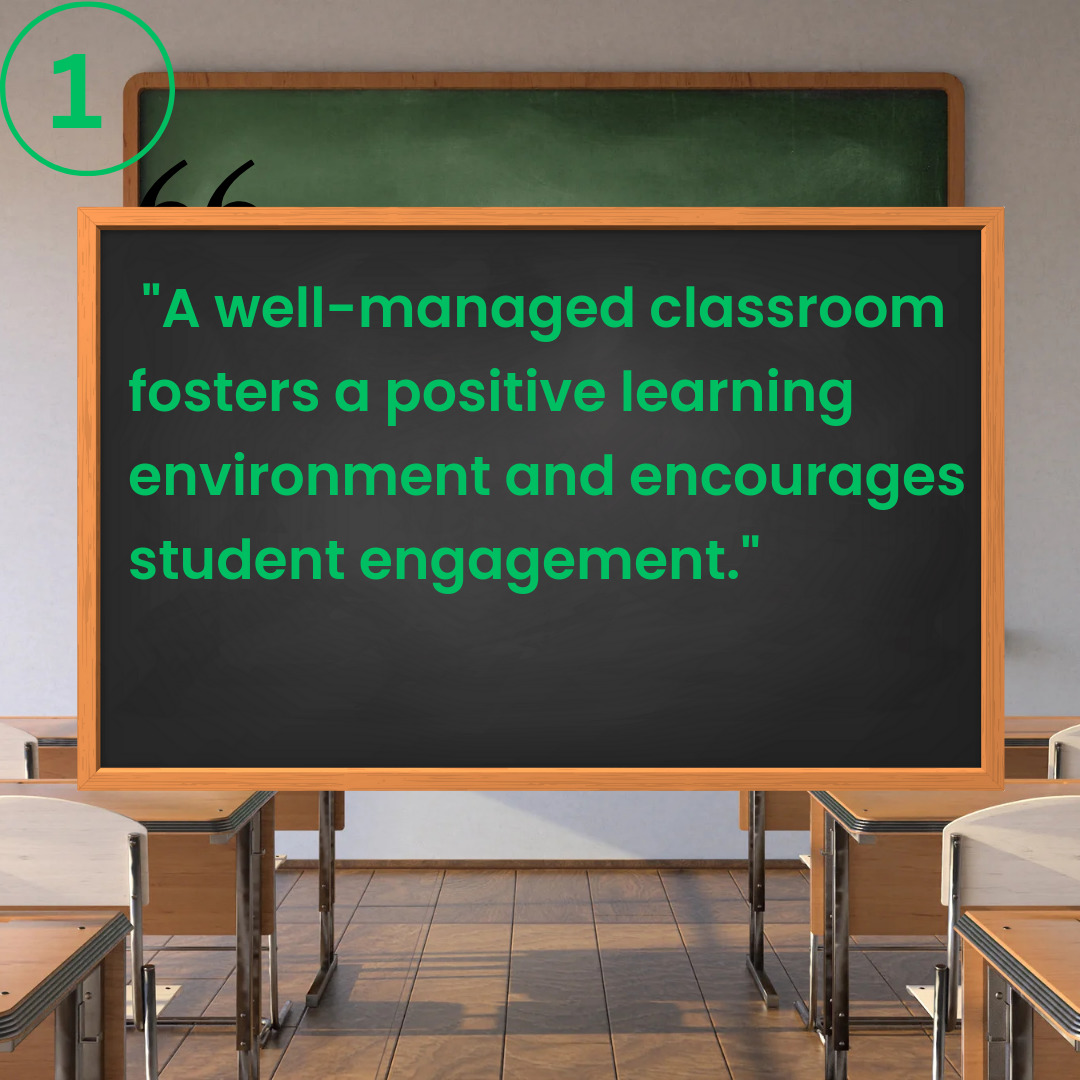
Classroom management is a cornerstone of effective teaching and a critical educator competency. It is the technique through which teachers create and maintain appropriate student behavior in classroom settings. The objective is to foster a productive learning environment that provides all students with opportunities to attain academic success. In this comprehensive guide, we delve into the intricacies of classroom management, shedding light on various strategies teachers can utilize to maximize learning, enhance student engagement, and foster a positive classroom climate.
Understanding Classroom Management
Definition of Classroom Management
Classroom management encompasses a broad spectrum of activities, strategies, and techniques teachers employ to ensure the classroom environment is conducive to learning. It includes designing effective instructional strategies, organizing the physical layout of the classroom, managing student behavior, promoting mutual respect, and implementing classroom procedures and routines. Through classroom management, teachers aim to minimize disruptive behavior and maximize student engagement and productivity.
Importance of Classroom Management in Education
Classroom management plays an integral role in the educational process. Here’s why:
- Promotes an Effective Learning Environment: Effective classroom management creates a favorable learning environment. It reduces distractions and interruptions, enabling students to focus better on tasks.
- Fosters Academic Success: Classroom management promotes academic achievement by creating a structured and predictable learning environment. It provides the framework for effective teaching and learning.
- Develop Essential Life Skills: Classroom management helps develop critical life skills such as discipline, respect for others, cooperation, and responsibility. These skills are essential for academic success, personal development, and career success.
- Enhances Teacher-Student Relationships: Effective classroom management fosters positive teacher-student relationships. It helps create mutual respect and rapport, leading to a supportive and inclusive classroom community.
- Improves Classroom Climate: A well-managed classroom promotes a positive classroom climate marked by enthusiasm, creativity, and mutual respect. Such an environment encourages students to participate actively and enjoy the learning process.
Classroom management is not merely about enforcing rules and discipline. It is about creating a nurturing and structured environment where students feel safe, engaged, and motivated to learn. It’s about shaping the conditions for students to thrive and achieve their full potential. However, the strategies for managing classrooms effectively can vary greatly depending on various factors, which we will explore in the following sections.
Theoretical Frameworks for Classroom Management Strategies
Several theoretical frameworks have influenced our knowledge of and use of efficient management techniques in the classroom. These theories give educators a framework for building their methods for creating a positive learning environment. This section highlights the behaviorist, humanist, cognitive, and ecological theoretical frameworks.
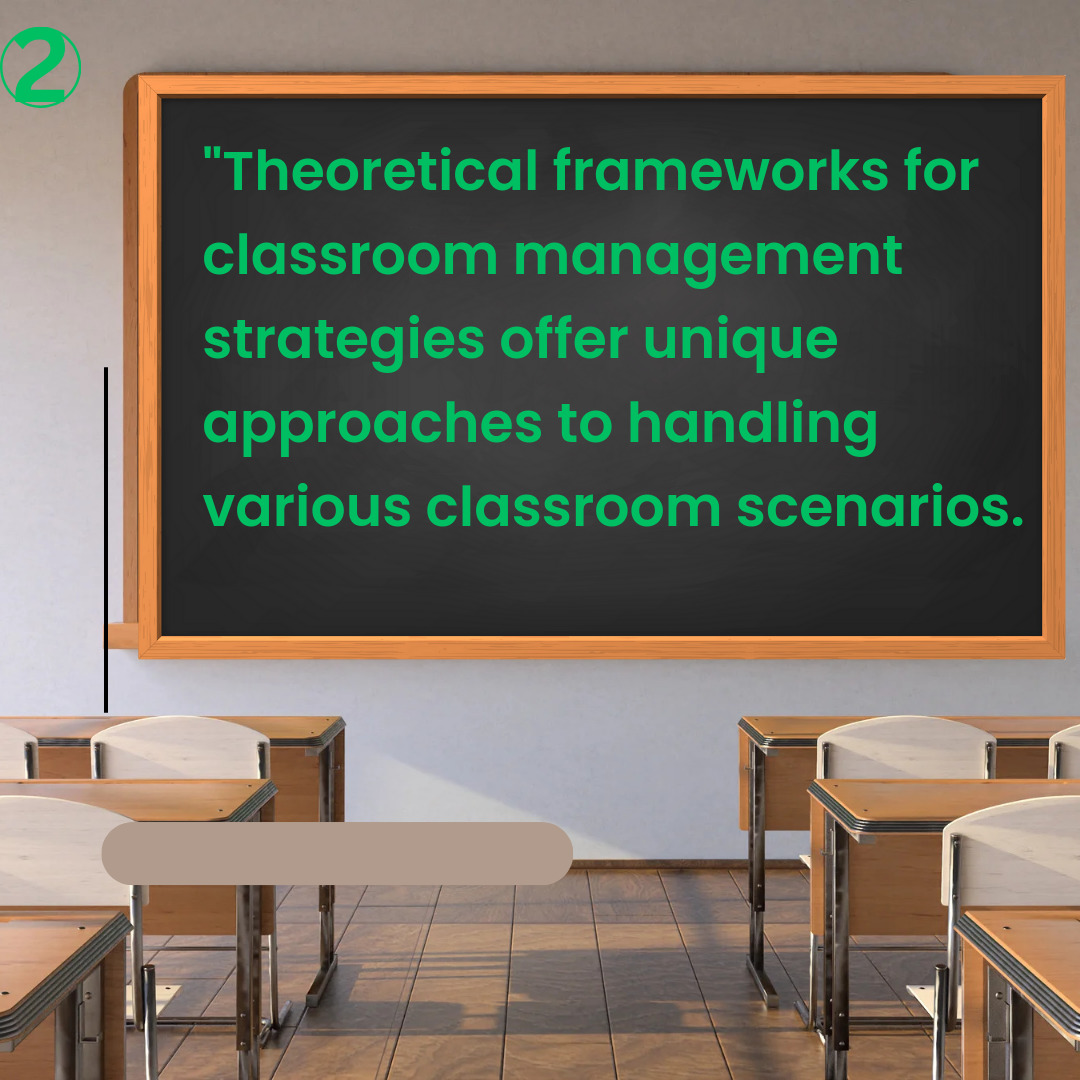
Behaviorist Strategies for Classroom Management
Behaviorist tactics stress manipulating observable actions through incentives and punishments. They have their roots in the writings of psychologists like B.F. Skinner. The underlying idea is that behavior may be modified by managing its effects.
Behaviorist teaching methods in the classroom use a system of rewards for desired actions and punishments for undesirable ones. For instance, teachers may commend students for being on time, participating fully, and adhering to classroom norms while disciplining disruptive conduct. The intention is to encourage an effective learning environment by reinforcing positive behaviors and discouraging harmful ones.
Humanist Strategies for Classroom Management
Contrasting the behaviorist viewpoint, humanist strategies, inspired by thinkers like Abraham Maslow and Carl Rogers, emphasize individual students’ experiences and emotions. The central tenet is that students are intrinsically motivated to learn and that classroom management should foster this internal drive.
Humanist strategies involve creating a classroom environment that addresses students’ physiological and psychological needs. This could include ensuring a safe and comfortable physical environment, fostering an emotionally supportive and respectful classroom climate, and providing learning opportunities that are meaningful and engaging for the students. The aim is to cultivate a learning environment where students feel valued, understood, and motivated to learn.
Cognitive Strategies for Classroom Management
Cognitive strategies, deriving from the cognitive theory of learning, focus on the mental processes involved in learning. They recognize that students’ perceptions, beliefs, and thought processes significantly impact their behavior and engagement in learning.
Cognitive strategies involve teaching students self-regulation skills, helping them set and monitor personal learning goals, fostering a growth mindset, and promoting problem-solving and critical thinking skills. The objective is to cultivate students’ cognitive abilities and empower them to take ownership of their learning.
Ecological Strategies for Classroom Management
Finally, based on Urie Bronfenbrenner’s ecological systems theory, ecological strategies consider the interconnectedness of various environmental systems influencing a student’s behavior and learning. These systems include the immediate learning environment, the home environment, and the broader community and societal context.
From an ecological perspective, classroom management strategies involve fostering strong school-home links, creating a culturally responsive classroom, and addressing socio-emotional factors affecting student behavior and learning. The aim is to create a harmonious and supportive learning environment that acknowledges and addresses the various environmental factors impacting students.
The ecological approach to managing a classroom requires attention to three primary aspects of the school environment. These include:
- The design of the classroom
- The methods of teaching.
- Protections against disruptive conduct.
These three aspects, taken together, encompass everything that should be included in a child’s educational setting.”
Summary: These theoretical frameworks offer different perspectives on classroom management. Effective classroom management strategies typically incorporate elements from all these frameworks, adapting to the student’s specific needs and classroom dynamics.
Key Components in Classroom Management Strategies
Effective classroom management is a multifaceted task that encompasses several key components. These elements create a conducive learning environment, promote student engagement, and ensure smooth classroom operations. Below, we explore these key components in greater detail.
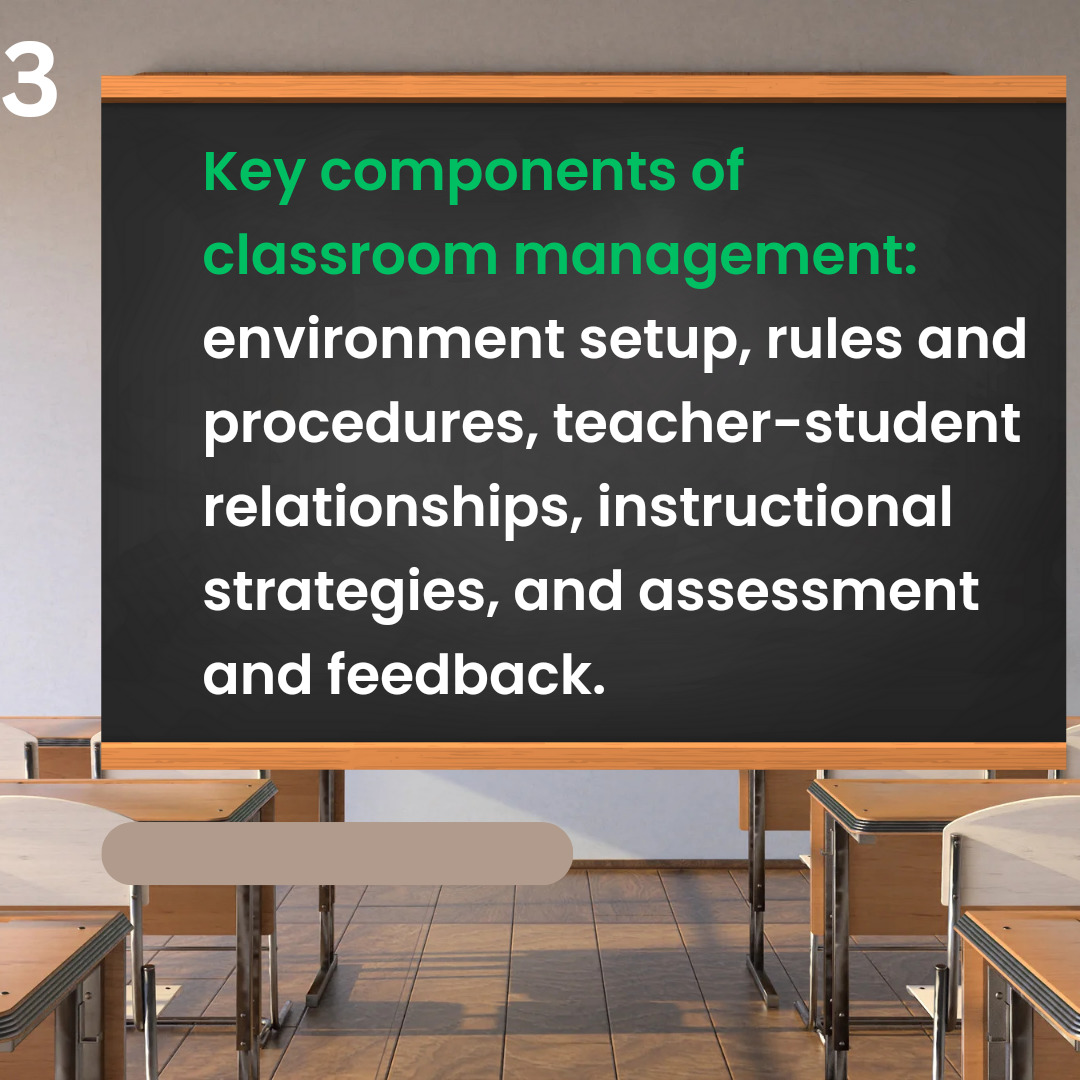
Classroom Environment and Physical Layout
The physical organization of a classroom significantly impacts student behavior and learning. An effectively organized classroom promotes smooth transitions, reduces distractions, and enhances understanding. This includes arranging desks to encourage student interaction, ensuring all students can see and hear, designating areas for different activities (like reading, group work, etc.), and displaying relevant instructional materials. Moreover, a welcoming and warm classroom environment fosters a sense of belonging and respect, enhancing student motivation and engagement.
Establishing Rules and Procedures
Establishing clear, consistent, and fair rules and procedures forms the backbone of effective classroom management. Regulations set the standards for acceptable behavior, while practices guide students on what to do in specific situations. For instance, procedures could be set for entering the classroom, submitting assignments, or transitioning between activities. Rules and policies should be communicated clearly, often at the start of the academic year, and reinforced consistently to ensure smooth classroom functioning.
Building Positive Teacher-Student Relationships
Developing strong, positive relationships with students is crucial for effective classroom management. When students feel respected, understood, and cared for, they are more likely to engage in learning and abide by classroom rules. Building these relationships involves showing interest in students’ lives, respecting their individuality, being fair and consistent, and demonstrating empathy and understanding. Positive teacher-student relationships can mitigate behavioral issues and foster a supportive and inclusive classroom community.
Implementing Effective Instructional Strategies
Effective instructional strategies are integral to classroom management. When lessons are engaging, relevant, and appropriately challenging, students are more likely to stay focused and less likely to display disruptive behavior. Effective instructional strategies include active learning techniques, differentiated instruction for diverse learners, clear and concise instructions, and timely feedback to guide students’ learning.
Conducting Fair and Consistent Assessment and Feedback
Assessment is vital to classroom management, evaluating student learning, guiding instructional decisions, and motivating students. Fair, consistent, and transparent assessment practices give students clear expectations for their knowledge and provide valuable feedback on their progress. These practices involve a mix of formative and summative assessments, self-assessments, and peer assessments. When timely and constructive, feedback helps students understand their strengths and areas for improvement, fostering their learning and motivation.
Summary: These key components provide the foundation for effective classroom management. By addressing these elements, educators can create a structured, respectful, and engaging learning environment that facilitates student success.
Detailed Examination of Classroom Management Strategies
Effective classroom management involves a dynamic interplay of various strategies. These strategies can be broadly classified into proactive, reactive, relationship-building, instructional, and assessment. Understanding these classifications can help teachers adopt a more nuanced and comprehensive approach to classroom management.
Proactive Strategies
Proactive classroom management strategies involve actions taken to prevent potential problems before they occur. They focus on establishing a positive learning environment that minimizes disruptions and maximizes student engagement. Examples include:
- Setting Clear Expectations: At the start of the school year, define and communicate expectations for behavior, procedures, and academic performance. Consistently reinforce these expectations to maintain a stable learning environment.
- Organizing Physical Layout: Arrange the classroom to facilitate easy movement, encourage interaction, and minimize distractions. This includes strategically placing desks, designating areas for specific activities, and ensuring visibility and audibility for all students.
- Planning Engaging Lessons: Prepare lessons that are engaging, relevant, and appropriately challenging to keep students focused and motivated.
Reactive Strategies for Classroom Management
Reactive strategies involve responding to disruptions or issues that arise despite proactive measures. The aim is to address these issues effectively in the learning process. Examples include:
- Using Non-Verbal Cues: Non-verbal cues, such as eye contact or hand signals, can effectively address minor disruptions without interrupting the lesson.
- Implementing a Discipline Plan: Develop a fair and consistent plan to deal with significant disruptive behavior. This plan could involve various interventions, ranging from verbal warnings to more substantial consequences.
Relationship Building Strategies
Positive relationships form the cornerstone of an effective classroom. Building and maintaining these relationships fosters an inclusive and respectful learning community. Examples include:
- Showing Interest in Students: Show genuine interest in students’ lives and experiences. This might involve casual conversations, attending extracurricular activities, or incorporating their interests into lessons.
- Promoting Respect and Empathy: Foster a classroom culture that values respect, empathy, and kindness. Model these values in your interactions and encourage students to do the same.
Instructional Strategies
Effective instruction goes hand in hand with classroom management. When lessons are engaging and education is clear, students are less likely to get distracted and more likely to engage in learning. Examples include:
- Using Active Learning Techniques: Engage students in the learning process through techniques such as discussion, group work, hands-on activities, and problem-solving.
- Differentiating Instruction: Differentiate instruction to cater to your students’ diverse needs and abilities. This might involve varied content, processes, or products based on students’ readiness, interest, or learning profile.
Assessment Strategies
Assessment and feedback are integral parts of classroom management. They guide learning, motivate students, and inform instructional decisions. Examples include:
- Using Formative Assessment: Continuously monitor students’ understanding and progress through formative assessments like quizzes, reflections, or exit tickets.
- Providing Constructive Feedback: Provide students with timely, constructive feedback that helps them understand their strengths and areas for improvement.
Effective classroom management relies on a diverse toolkit of strategies. Teachers can create a well-managed and conducive learning environment by employing proactive, reactive, relationship-building, instructional, and assessment strategies.
Classroom Management Strategies for Specific Situations
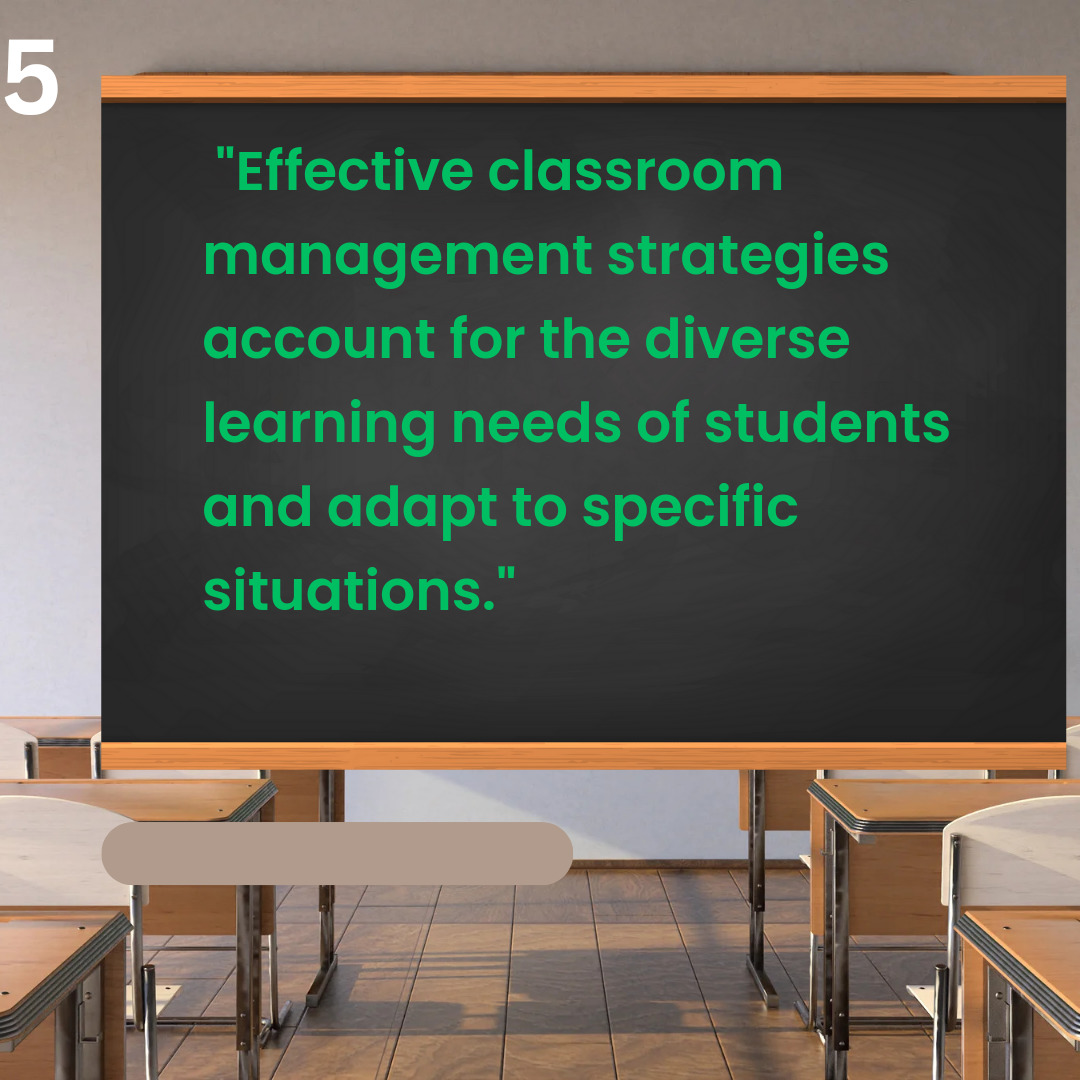
Different classroom situations often require distinct management approaches. Adjusting strategies based on specific circumstances is key to effective classroom management. This section examines schemes for managing disruptive behavior, handling diverse learning environments, and maintaining order in digital/online classrooms.
Managing Disruptive Behavior
Disruptive behavior can pose a significant challenge to classroom management. However, strategic responses can help mitigate these disruptions and promote positive behavior:
- Prevention: Often, the best way to manage disruptive behavior is to prevent it. Communicate behavior expectations, provide engaging instruction, and build positive teacher-student relationships.
- Non-Verbal Cues: Use non-verbal cues such as eye contact, hand signals, or proximity to address minor disruptions without interrupting the lesson.
- Consistent Consequences: Implement a discipline plan with consistent consequences for disruptive behavior. Ensure the results are appropriate, fair, and communicated to the students.
Classroom Management in Diverse Learning Environments
Diverse classrooms, with students of different abilities, backgrounds, and needs, require inclusive and responsive management strategies:
- Differentiated Instruction: Adjust the content, process, and instruction products based on students’ readiness, interest, or learning profile.
- Cultural Responsiveness: Show respect and understanding for students’ diverse cultural backgrounds. Include diverse perspectives in your curriculum and create a safe space for sharing and understanding different cultures.
- Inclusive Practices: Implement practices that include all students, regardless of their abilities or needs. This might involve adaptive materials, accommodations or modifications, and collaborative learning activities.
Classroom Management in Digital/Online Classrooms
The shift to digital and online learning has presented new challenges for classroom management. The following strategies can help maintain order and engagement in these contexts:
- Clear Expectations: Communicate online behavior, participation, and assignment submission expectations, which differ from those in a physical classroom.
- Interactive Online Tools: Use interactive tools to engage students in the online learning process. This could involve discussion forums, virtual whiteboards, breakout rooms, or online polls.
- Regular Feedback and Check-ins: Regularly check in with students and provide feedback to ensure they are engaged and on track with their learning. This could involve individual messages, online quizzes, or video meetings.
Summary: Effective classroom management strategies adapt to the specific dynamics and needs of the situation. Teachers can effectively manage various classroom scenarios by employing appropriate techniques for particular conditions and ensuring conducive learning environments for all students.
Impact of Effective Classroom Management Strategies
Classroom management strategies’ effectiveness is evident in their positive impacts on various aspects of the educational experience. This section will explore the influence of these strategies on academic performance, student behavior and engagement, and the overall classroom climate.
Influence on Academic Performance
Effective classroom management creates an environment conducive to learning, which directly influences academic performance:
- Increased Focus on Learning: Students can focus better on their work when classrooms are well-managed and disruptions are minimized. This increased focus leads to improved understanding and retention of material, which translates into improved academic performance.
- Enhanced Instructional Time: Effective classroom management strategies ensure that instructional time is used efficiently. Procedures for transitions, assignment collection, and other logistical tasks are streamlined, leaving more time for instruction and learning.
Effect on Student Behavior and Engagement
Classroom management strategies also have a profound impact on student behavior and engagement:
- Promotion of Positive Behaviors: Clear rules, consistent consequences, and positive teacher-student relationships help promote appropriate behaviors. As students internalize these behaviors, they become more self-regulated and responsible.
- Increased Student Engagement: Engaging instruction, active learning techniques, and a respectful classroom climate all foster student engagement. When students are engaged, they are more invested in their learning, participate more actively, and are less likely to be disruptive.
Contribution to Positive Classroom Climate
Classroom management strategies play a crucial role in shaping the classroom climate:
- Development of Respectful Relationships: Positive teacher-student relationships and respectful student-student relationships create a supportive, inclusive, and respectful classroom community. This positive community encourages students to take risks, express their thoughts, and support one another.
- Creating a Safe Learning Environment: Communicated expectations, fair consequences, and consistent routines create a predictable and safe learning environment. Students feel comfortable, secure, and ready to learn in such an environment.
Summary: Effective classroom management strategies profoundly impact academic performance, student behavior, engagement, and the classroom climate. By skillfully employing these strategies, teachers can foster successful learning outcomes, promote positive behavior, engage students, and create a supportive and conducive learning environment.
Challenges and Solutions in Classroom Management Strategies
While classroom management strategies are crucial for a successful learning environment, implementing them is challenging. Understanding these challenges and the potential solutions can provide teachers with valuable insights to navigate their classroom dynamics effectively.
Common Challenges in Classroom Management
Several challenges may arise in the pursuit of effective classroom management:
Diverse Learning Needs: Catering to students’ varied learning needs and styles can be challenging in a diverse classroom.
Disruptive Behavior: Despite setting clear expectations, teachers may still face disruptive behavior that impedes learning.
Engaging All Students: Engaging all students, particularly in larger classrooms, can prove difficult. Students have different interests and motivation levels, making universal engagement a significant challenge.
Adapting to New Technologies: With the advent of digital learning, teachers must adapt to new technologies and methods for managing digital classrooms.
Overcoming Challenges: Innovative and Effective Solutions
Despite these challenges, innovative and effective solutions can help to enhance classroom management:
- Differentiated Instruction: Teachers can use differentiated instruction to cater to diverse learning needs, adjusting their teaching techniques to meet students’ varied learning styles and abilities.
- Consistent and Fair Consequences: Implementing a system of consistent and fair consequences can mitigate disruptive behavior. It’s important to be calm and respectful while enforcing these consequences, emphasizing that they result from the behavior, not the student as a person.
- Interactive Learning Techniques: To engage all students, teachers can incorporate interactive learning techniques such as group work, class discussions, and hands-on activities. These methods can cater to different learning styles and interests.
- Professional Development: Teachers can attend professional development programs to learn about new technologies and methods for managing digital classrooms. Regular training and support can help teachers adapt and effectively use these tools.
While challenges in implementing classroom management strategies are inevitable, innovative and effective solutions exist. By understanding these challenges and being equipped with the right approach to overcome them, teachers can successfully create and maintain a conducive learning environment for all students.
The Future of Classroom Management Strategies
The landscape of education and classroom management is continuously evolving, influenced by technological advancements, educational research, and societal changes. This section will explore upcoming classroom management trends, technology’s role in future classroom strategies, and the importance of continuous professional development for teachers.
Upcoming Trends in Classroom Management
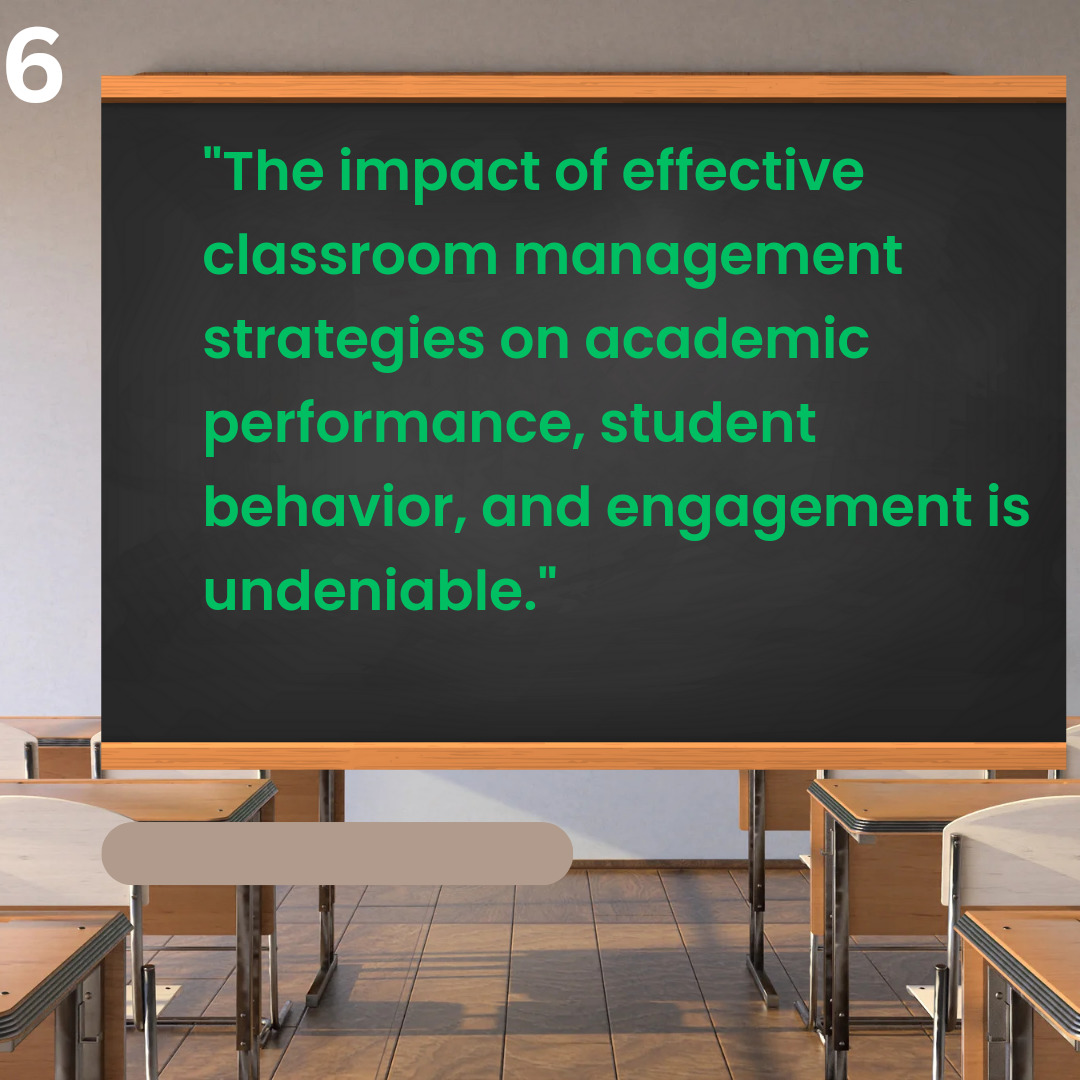
As education continues to evolve, so too do the trends in classroom management:
- Student-Centered Learning: Classroom management strategies will likely follow suit as education becomes increasingly student-centered. This means more emphasis on developing students’ self-regulation skills, providing personalized learning opportunities, and empowering students to take more ownership of their learning and behavior.
- Social-emotional learning (SEL) teaches students to manage emotions, build positive relationships, and make responsible decisions. Incorporating SEL into classroom management strategies can help create a supportive learning environment and promote positive behavior.
- Mindfulness and Mental Health: As people become more aware of the importance of mental health, strategies promoting mindfulness and emotional well-being will likely become more common in classrooms.
Role of Technology in Future Classroom Management
Technology will continue to play a significant role in classroom management:
- Digital Tools: New digital tools will continue to emerge to help with various aspects of classroom management, from tracking behavior and attendance to facilitating communication between home and school.
- AI and Machine Learning: AI and machine learning may be used to analyze classroom data and provide insights to help teachers improve classroom management. For instance, these tools could identify patterns in student behavior or suggest personalized learning strategies.
- Virtual Reality (VR) and Augmented Reality (AR): VR and AR could be used for immersive learning experiences, offering new classroom management possibilities. Teachers could use these technologies to simulate real-world scenarios and teach students how to navigate them effectively.
The Importance of Continuous Professional Development for Teachers
As classroom management strategies evolve, continuous professional development becomes increasingly important:
- Keeping Up with New Strategies: Ongoing professional development can help teachers stay current on the latest research and trends in classroom management.
- Learning New Technologies: As more digital tools become available for classroom management, teachers will need ongoing training to use these tools effectively.
- Building a Professional Network: Professional development also provides opportunities for teachers to connect with colleagues and share strategies, challenges, and solutions.
The future of classroom management is dynamic, shaped by upcoming trends, technological advancements, and the need for continuous professional development. As teachers prepare for this future, they can embrace these changes as opportunities to enhance their classroom management strategies and create even more effective learning environments for their students.
Summary and Conclusion
As we conclude this in-depth examination of classroom management strategies, it is important to recap the crucial points covered and consider their implications for teaching practice.
Recap of Classroom Management Strategies
Classroom management is a multifaceted concept involving everything from the organization of the physical environment to the relationships between teachers and students. Effective classroom management strategies are rooted in various theoretical frameworks, including behaviorist, humanist, cognitive, and ecological models. They involve strategically organizing the classroom environment, establishing clear rules and procedures, building positive teacher-student relationships, and implementing effective instructional and assessment strategies.
Additionally, classroom management strategies need to adapt to specific situations, such as managing disruptive behavior, facilitating learning in diverse classrooms, and navigating the challenges and opportunities of digital classrooms. These strategies profoundly impact academic performance, student behavior and engagement, and the overall classroom climate. Despite the difficulties in implementing these strategies, innovative solutions can help teachers create a conducive learning environment.
Looking ahead, the future of classroom management is shaped by upcoming trends like student-centered learning, social-emotional learning, and mindfulness and is driven by technological advancements. In this changing landscape, continuous professional development will be key for teachers to stay current and effectively adapt their classroom management strategies.
Final Thoughts and Implications for Practice
Classroom management strategies are the backbone of successful teaching practice. They create an environment conducive to learning, promote positive behavior, and foster student engagement. These strategies are not one-size-fits-all but must be tailored to each classroom’s unique needs and circumstances. They require a teacher’s constant attention, reflection, and adjustment.
As teachers, staying informed about the latest research and classroom management trends is crucial. Teachers must also be open to learning and implementing new strategies and ready to adapt in the face of challenges and changes. By doing so, they can continually enhance their classroom management skills and facilitate successful student learning outcomes.
Classroom management is a dynamic and vital aspect of education with significant implications for practice. It offers endless opportunities for learning, growth, and innovation, potentially profoundly impacting students’ educational experiences.
Classroom management is crucial for effective teaching and learning.
- Sets the stage for discussing strategies, their importance, and how they evolved.
- Classroom management is a set of techniques used to ensure the smooth running of the classroom.
- It’s critical for providing an environment conducive to learning.
- Frameworks include Behaviorist, Humanist, Cognitive, and Ecological models.
- Each model offers a unique approach to managing classrooms.
- Key components include setting up the environment, rules and procedures, teacher-student relationships, instructional strategies, and assessment and feedback.
- Each component plays a significant role in the overall classroom experience.
- Different strategies are examined, including proactive, reactive, relationship-building, instructional, and assessment.
- Understanding these strategies can help teachers manage their classrooms more effectively.
- Discusses managing disruptive behavior, managing diverse learning environments, and managing digital/online classrooms.
- It’s important to adapt classroom management strategies to specific situations.
- Effective strategies impact academic performance, student behavior, engagement, and the classroom climate.
- Effective classroom management promotes a positive learning environment.
- Common challenges include diverse learning needs, disruptive behavior, student engagement, and adapting to new technologies.
- Solutions involve differentiated instruction, fair consequences, interactive learning techniques, and professional development.
- Upcoming trends in classroom management include student-centered learning, social-emotional learning, and mindfulness.
- Technology will continue to play a significant role, with AI, machine learning, VR, and AR potential tools.
- Continuous professional development will be crucial for teachers to adapt and stay current.
- Classroom management strategies are crucial for successful teaching and must be tailored to each classroom’s unique needs.
- Continuous learning and adaptation in the face of challenges are necessary.
- The future of classroom management offers opportunities for growth and innovation.
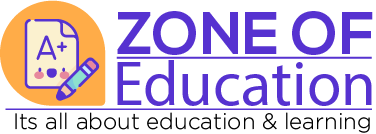


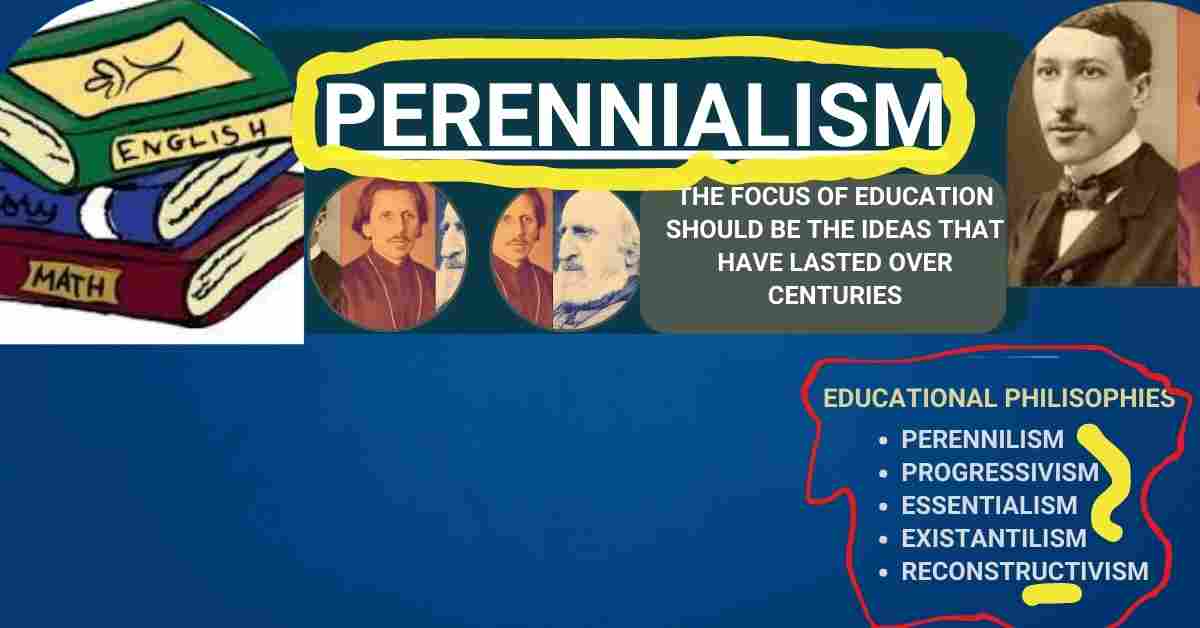


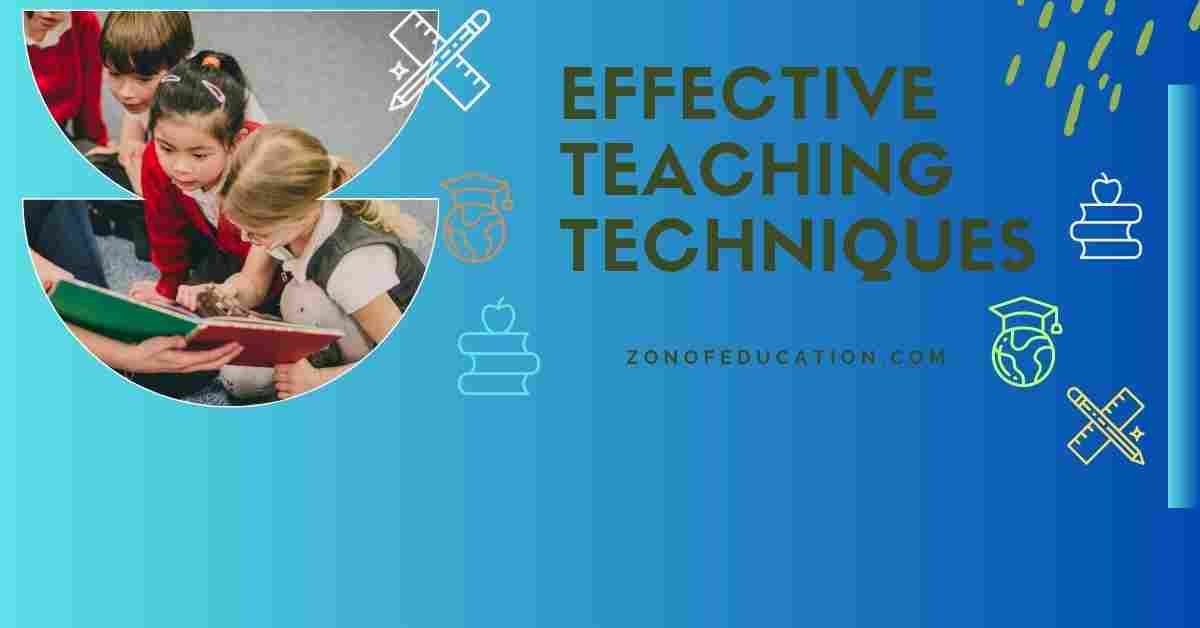
[…] role of a teacher is essential in shaping a student’s life and guiding them toward a brighter future. Perennialism, an educational philosophy emphasizing the enduring […]
[…] Method: Facilitates a student-centered environment, with the teacher as a guide and facilitator of […]
[…] test and assessment performance provides feedback to teachers on the effectiveness of their instructional methods and guides improvements. If class-wide results on an end-of-unit test are poor, the teacher reflects on how […]
[…] Engaging students in the learning process is crucial for their academic success. When students are actively engaged, they are more likely to retain information, develop critical thinking skills, and apply their knowledge to real-world situations. To encourage student engagement, teachers can employ various strategies. […]
[…] and growth of students are deeply intertwined with the strategies teachers employ. By approaching classroom management with empathy, patience, and genuine care, educators can create an atmosphere where students feel […]
[…] Teachers should act as facilitators and guides, rather than authoritarian figures. […]
[…] of the key advantages of the Assignment Tool is its ability to streamline the grading process. Teachers can grade assignments directly within Google Classroom, providing comments and feedback that are accessible to students. The tool also allows for easy […]
[…] with peers, and take ownership of their learning journey. In a student-centered classroom, the teacher guides and supports students’ exploration and understanding of […]
[…] Learning: Helps identify strengths and weaknesses, guiding teachers in modifying instruction for better student […]
[…] and monitor their progress. Assessment for Learning involves using assessments to inform and guide teaching and learning strategies. Informal and formal assessments differ in their structure and administration. Internal assessments […]
[…] Classroom Model: A high school science teacher implements the flipped classroom model by creating pre-recorded video lectures for students to watch at home, freeing up class time […]
[…] a sense of authority and respect for the teacher’s role in guiding and directing student […]
[…] learner-centered approach is another essential principle, with teachers working as guides and facilitators to assist pupils develop critical thinking […]
[…] to enhance their knowledge, skills, and practices. They offer guidance on instructional techniques, classroom management strategies, assessment methods, and interventions for students with diverse learning […]
[…] technology to enhance learning experiences, or fostering a positive learning environment through classroom management strategies, educational psychology provides evidence-based guidance that supports effective teaching […]